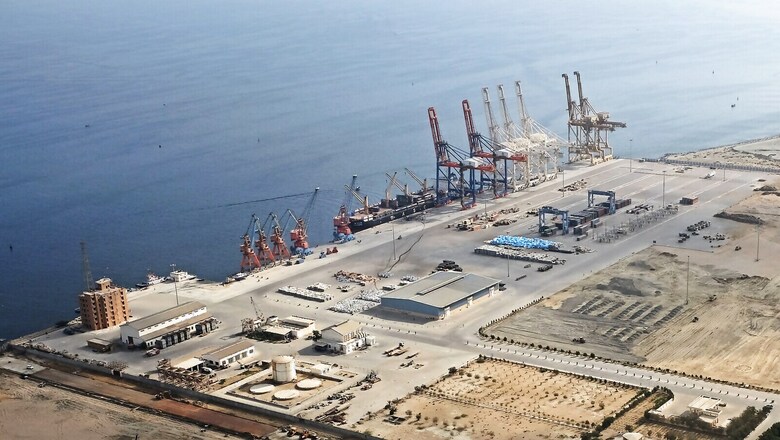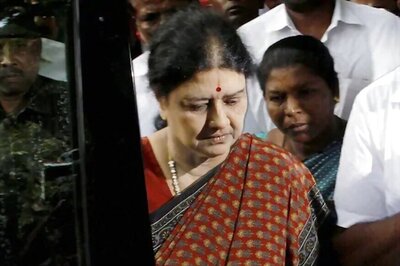
views
Something quite remarkable is happening in Gwadar, the port city in Balochistan, which is the lynchpin of the ambitious China-Pakistan Economic Corridor (CPEC). For a month now, a mammoth protest has been underway in which virtually the entire population of the city has been out on the streets demanding basic rights denied to them for years—water, electricity, secure livelihoods, a drugs-free environment, freedom from harassment by overbearing and insulting security protocols.
As is usual with everything Balochistan, the protest was initially ignored by the so-called mainstream media of Pakistan. Like some other parts of Pakistan, Balochistan has always been a bit of a black hole for news. Media organisations are discouraged from airing or printing anything that the military, intelligence agencies and government doesn’t like or doesn’t want to be publicised. But the sheer scale of the protests in Gwadar have made it impossible for ‘mainstream’ media to censor news coming out of the port city, especially since social media was fast becoming the go-to source of news.
The story has become even more compelling because the protests are no longer limited to only Gwadar and now involve local communities across the Makran coastal belt. In fact, what started as ‘Gwadar ko Haq do’ (Give Gwadar its rights) movement is now transforming into ‘Balochistan ko Haq do’ movement. The man spearheading the protest, Maulana Hidayat Ur Rehman, has plans to take the protests—a million man march—to the provincial capital Quetta. The sort of support that the Gwadar rights movement is attracting lends to it the potential to snowball into a province-wide movement. Not only is it capturing the imagination of people across the restive province, it is also forcing the power elites to sit up and take notice.
As is their wont, the authorities in Quetta, Islamabad and the seat of real government in Pakistan—Rawalpindi—responded to the protests in time-honoured fashion. Initially they ignored the protests. Nobody imagined that the protest will grow into what it has. When the crowds started becoming bigger, the provincial government—the new chief minister Abdul Quddus Bizenjo is from the Makran region—claimed that they had started to deliver on the demands of the protestors. But this is a standard operating procedure—meet the demands on paper without doing anything on ground. The Gwadar movement wasn’t impressed.
At that stage a two-pronged strategy was adopted. A campaign to paint the protest as anti-national, anti-state and anti-CPEC was launched. But it bombed. Alongside, a large number of security forces were despatched to Gwadar. The threat of using the strong arm of the state to break up the protests was held out. But this threat didn’t scare the protestors. Finally, Imran Khan took ‘notice’ and promised to meet the demands of the movement. But even this has not worked because the protestors have made it clear that they need to see actual delivery and not promises on paper. This is where matters stand currently.
What CPEC Has Given to the Locals
The Makran belt has for long been the hub of insurgency by Baloch separatists who enjoy huge support in this region. But the interesting thing about the Gwadar movement is that it seems to have upstaged the nationalists and separatists. Hidayat Ur Rehman is a leader of the Islamist party Jamaat-i-Islami which never really had any great following in Balochistan. Despite being the provincial general secretary of the Jamaat-i-Islami, Rehman was not a very prominent political figure. But because he is a local and understands and identifies with the problems being faced by the people, he has been able to cut through the tired rhetoric of the nationalists by focusing on basic bread and butter issues. He has mobilised the masses by keeping things simple and connecting with the people by raising the daily indignities and problems denizens of Gwadar, especially women, face. In fact, one of the most striking features of the protest is the huge participation of women in the demonstrations and sit-ins.
The fact that Rehman is from the Jamaat and not any nationalist or separatist party has tempered the reaction from the Pakistani state which would otherwise have been tempted to brutally crush the protest. What has also helped is that there are no big tribal chieftains who hold sway in the Makran belt and who could have been used to sabotage the movement. But it also has to be conceded that Rehman has played his cards very smartly. He has taken a leaf out of the book of the Pashtun Tahafuz Movement (PTM) by keeping his movement peaceful and within the four corners of law and constitution. Unlike the nationalists who have debunked the CPEC, Rehman has declared that he isn’t against CPEC but has asked what CPEC has given to the locals except check-posts of security forces and coffins.
In fact, many of Gwadar’s problems have started because of CPEC. What was supposed to be a project that would transform the lives of the people has actually made them aliens in their own land. The locals have been barred from many parts of the city where CPEC projects are being undertaken. Because of the insurgency in Balochistan, every Baloch is a suspect in the eyes of the security forces who are predominantly Punjabi or Pashtun and treat the local Baloch with disdain. The security protocols imposed on the people are demeaning with constant checks and humiliation, even extortion by the Punjabi army.
Instead of creating employment for locals—hardly any local has been employed on the Chinese-funded projects—the Chinese influx has actually deprived them of even their traditional livelihoods. Fishing was the main occupation in Gwadar. But after the Chinese moved in and built the port and supporting infrastructure, the access to sea has been restricted for many fishermen. The presence of Chinese trawlers in the waters around Gwadar and rest of the coast has depleted the fish stocks, threatening the traditional fishing communities of Gwadar.
Fresh water was always scarce in Gwadar. When CPEC was launched, there were plans to address the issue of water supply. But nearly 20 years after the Gwadar port was built and eight years after the Chinese took it over as part of CPEC, the local population’s water woes have only increased. The insensitivity of the Pakistani forces which behaves more like an occupation army than a national army can be gauged by the fact that they have built a cricket stadium in which the soil was imported from Punjab and which has a lush green grass outfield while most of Gwadar goes thirsty. The electricity situation too is abysmal as far as the locals are concerned. Add to this the fact that Gwadar has become a hub for narcotics and human trafficking. The narcotics trade has had a devastating impact on the local population.
A Threat to Chinese Project?
None of these issues on which the current agitation is built is new. In fact, there have been any number of protests in the past. But they were always ignored because none of them managed to gain the critical mass required for them to be noticed. The ‘Gwadar ko Haq do’ movement has changed all that. It has harnessed the angst and desperation of the people and galvanised them into a movement that simply cannot be ignored or brushed under the carpet.
While there is no Rihanna asking why the world is not talking about the Gwadar movement, no Greta Thunberg lending her voice to a movement which is about sustainable livelihoods and environment, no other Hollywood busybodies or Senators and Congressmen doing virtue-signalling in support of this movement, no paid public relations firms creating an international campaign in support of the oppressed, suppressed and repressed people of Gwadar, the protests have gained enormous traction in Pakistan.
Activists and politicians from across Pakistan are now lending their voices in support of not just the fight for rights in Gwadar but also Balochistan. Hidayat Ur Rehman has become an iconic figure, quite like Manzoor Pashteen of PTM. The Chinese are meanwhile watching warily at how this movement progresses. Already many CPEC projects are either languishing or in a go-slow mode. While the spectre of separatist violence was always hanging over CPEC, this new political movement, something that the Chinese are not quite used to handling, will only add to the sense of disquiet about the future of CPEC and its viability.
Sushant Sareen is Senior Fellow, Observer Research Foundation. The views expressed in the article are those of the author and do not represent the stand of this publication.
Read all the Latest Opinions here




















Comments
0 comment